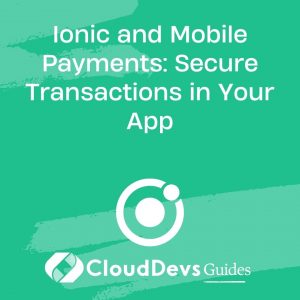Ionic and Mobile Payments: Secure Transactions in Your App
Mobile payments have become an integral part of our daily lives. Whether it’s for shopping online, ordering food, or booking a ride, the convenience of making payments through mobile apps is undeniable. As a developer, integrating secure mobile payment solutions into your app is crucial for enhancing user experiences and boosting your app’s success. In this blog, we will dive into the world of Ionic and mobile payments, exploring the benefits, implementation, and providing code samples to help you get started.
Table of Contents
1. The Rise of Mobile Payments
Mobile payments have witnessed exponential growth in recent years. With the advent of smartphones, mobile wallets, and digital payment platforms, consumers have gradually shifted away from traditional payment methods like cash and credit cards. The reasons for this shift are numerous:
1.1. Convenience
Mobile payments offer unparalleled convenience. Users can make payments from the comfort of their homes or while on the go, eliminating the need to carry cash or credit cards.
1.2. Security
Security is a top priority for both consumers and developers. Mobile payment solutions come with robust security measures, including encryption, tokenization, and biometric authentication, making transactions safer than ever.
1.3. Speed
Mobile payments are lightning-fast. Transactions are processed in seconds, reducing wait times at checkout counters and enhancing the overall shopping experience.
1.4. Accessibility
Mobile payments are accessible to a broad user base. As smartphone penetration continues to rise globally, more people have access to mobile payment options.
2. Why Choose Ionic for Mobile Payments?
Ionic is a popular open-source framework for building cross-platform mobile applications using web technologies such as HTML, CSS, and JavaScript. It offers several compelling reasons for choosing it as your platform for implementing mobile payments:
2.1. Cross-Platform Compatibility
Ionic allows you to develop apps that work seamlessly on both Android and iOS devices. This cross-platform compatibility saves time and resources compared to building separate native apps for each platform.
2.2. Rapid Development
Ionic provides a wide range of pre-built UI components and plugins, speeding up the development process. This is crucial when you need to integrate complex features like mobile payments.
2.3. Community and Support
The Ionic community is active and supportive. You can find extensive documentation, tutorials, and forums to help you tackle any development challenges, including payment integration.
3. Implementing Mobile Payments with Ionic
Now, let’s delve into the practical aspects of implementing mobile payments in your Ionic app. We’ll use a hypothetical e-commerce app as an example. Here are the steps you need to follow:
3.1. Choose a Payment Gateway
Select a payment gateway that suits your app’s needs. Popular options include Stripe, PayPal, and Square. Each gateway has its own API and documentation for integrating payments into your app.
3.2. Set Up Your Development Environment
Ensure you have Node.js and the Ionic CLI installed on your system. You’ll also need to create an Ionic project or use an existing one as the foundation for your app.
3.3. Install Payment Gateway SDK
Install the SDK (Software Development Kit) for your chosen payment gateway. For instance, if you’re using Stripe, you can install the Stripe Cordova plugin with the following command:
bash ionic cordova plugin add cordova-plugin-stripe
npm install @ionic-native/stripe
3.4. Create a Payment Page
Design a user-friendly payment page where users can enter their payment information. You can use Ionic’s UI components to create an intuitive and aesthetically pleasing interface.
3.5. Implement Payment Logic
Now comes the crucial part – integrating the payment logic. You’ll need to write TypeScript code to interact with the payment gateway’s API. Below is a simplified example of how you might handle a payment with Stripe in your Ionic app:
typescript
import { Component } from '@angular/core';
import { Stripe } from '@ionic-native/stripe/ngx';
@Component({
selector: 'app-payment',
templateUrl: 'payment.page.html',
})
export class PaymentPage {
constructor(private stripe: Stripe) {}
makePayment() {
this.stripe.setPublishableKey('your_publishable_key');
const card = {
number: '4242424242424242',
expMonth: 12,
expYear: 2025,
cvc: '123',
};
this.stripe
.createCardToken(card)
.then((token) => {
// Send the token to your server for processing
console.log('Payment successful! Token: ' + token.id);
})
.catch((error) => {
console.error('Error processing payment: ' + error);
});
}
In this example, you first import the Stripe module, set your publishable key, and create a card object with the user’s payment information. When the user clicks the “Pay” button, the makePayment function is called, which creates a card token using the Stripe API. You can then send this token to your server for further processing.
3.6. Test Your Payment Flow
Before deploying your app, thoroughly test the payment flow to ensure everything works as expected. Most payment gateways provide testing environments and test card details for this purpose.
4. Enhancing Security in Ionic Mobile Payments
Security is paramount when dealing with mobile payments. Here are some best practices to enhance the security of your Ionic app’s payment system:
4.1. Use Tokenization
Tokenization is the process of replacing sensitive payment data with a unique token. This token can be safely stored and transmitted without exposing the actual payment information, reducing the risk of data breaches.
4.2. Implement Two-Factor Authentication (2FA)
Consider implementing two-factor authentication for user accounts. This adds an extra layer of security, requiring users to verify their identity through a second factor, such as a one-time password sent to their mobile device.
4.3. Regularly Update Dependencies
Keep your Ionic framework and payment gateway SDKs up to date. Updates often include security patches that address newly discovered vulnerabilities.
4.4. Secure Backend Communication
Ensure that communication between your app and your server is secure. Use HTTPS to encrypt data transmission, and implement server-side security measures to protect against attacks like SQL injection.
5. The User Experience
A seamless user experience is essential for the success of your app. When implementing mobile payments, pay attention to the following aspects to ensure a positive user experience:
5.1. User-Friendly Interface
Design an intuitive and user-friendly payment interface. Clearly guide users through the payment process, and provide helpful error messages when necessary.
5.2. Payment Confirmation
After a successful payment, display a confirmation message and send a payment receipt via email or SMS. This reassures users that their transaction was successful.
5.3. Error Handling
Implement robust error handling to gracefully handle payment failures. Clearly communicate errors to users and guide them on how to resolve issues.
5.4. Security Notices
Educate users about the security measures in place. Let them know that their payment information is secure and explain the steps you’ve taken to protect their data.
Conclusion
Integrating mobile payments into your Ionic app can greatly enhance its value and convenience for users. With the right payment gateway, a secure implementation, and attention to user experience, you can create a seamless and trustworthy payment system that encourages users to transact with confidence.
Remember that security should always be a top priority. Stay updated with the latest security practices and regularly test your payment flow to ensure it remains robust and safe.
By following these guidelines and leveraging the power of Ionic, you can provide a secure and enjoyable mobile payment experience for your app’s users, setting your app up for success in the competitive world of mobile commerce.
Happy coding and secure transacting!
Table of Contents








